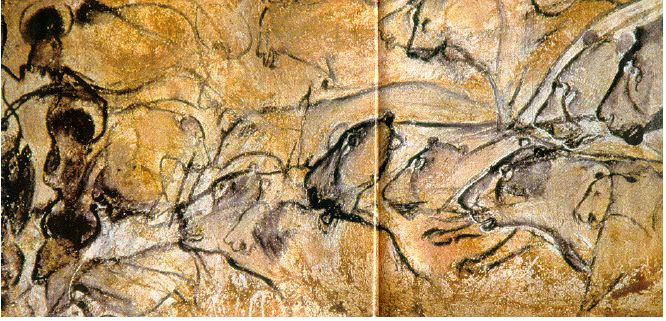
Featured Prehistoric Locality: The Chauvet Cave source of image
Notes for Evolution - The Triumph of an Idea - Chapter 12
Click link to return to Biology
409 Schedule
or back to Chapter 11
General guide on these review questions here
Chapter 12 - Modern Life, 50,000 B.C. - The Dawn of Us
PBS Website The Brain and Culture
Objectives:
a) Consider what prehistoric cave paintings reveal about significant milestones in the history of human evolution.
b) Contrast the older "multiregional" hypothesis with the currently favored "out-of-Africa" hypothesis, including their respective implications for the number of recent human species and recent extinction patterns.
c) Evaluate recent evidence that Neanderthals were a distinct northern species of humans that was likely driven to extinction by the northern spread of Homo sapiens.
d) Contrast the brain capabilities of "modern" H. sapiens with those of Neanderthals, based on artifacts each left behind.
e) Revisit the case of sickle-cell anemia from the perspective of someone who now has experience with current views of human evolution and natural selection processes.

Featured Prehistoric Locality: The Chauvet Cave source
of image
I. Introduction

source of image
RQ Ev-12.1:What is the primary sigificance of Jean-Marie Chauvet's 1994 discovery of a cave in the Ardéche region of France?
II. The First Moderns
 Featured
Scientist: Allan C. Wilson
Featured
Scientist: Allan C. Wilson
source
of image
Key Terms: Mitochondrial Eve (Links: 1 - 2 - 3 - 4 - 5 - 6 - 7 - 8)
RQ Ev-12.2: Given that many Homo erectus fossils are known from Asia that are at least one million years old, and the European fossils of Neanderthals date from about 200,000 to 30,000 years ago, how does the tree on p. 298 provide evidence that these humans have relatively little to do with the evolution of modern Homo sapiens?
RQ Ev-12.3: Succinctly contrast the conventional "multi-regional" hypothesis with the newer "out-of-Africa" hypothesis for the origin of modern humans, especially contrasting them with respect to the history of those people currently living in Asia.
III. Neanderthal DNA
RQ Ev-12.4: Assuming that the sampling of ancient DNA in Neanderthals has provided an accurate assessment of their gene sequences when they were alive, what does this sampling suggest about the relationship between Homo sapiens and Neanderthals?
IV. A New Kind of Mind
RQ Ev-12.5: What do cultural artifacts such as jewelry and ornaments reveal about the differences between Homo sapiens and H. neanderthalensis?
V. Unnatural Selection
RQ Ev-12.6: Most of you have already been taught about the heterozygote advantage associated with the sickle-cell trait. Summarize this situation again but from the perspective of ongoing evolution in Homo sapiens, as possibly a cost of the spread of agriculture in human society.
VI. Man-Made Evolution
RQ Ev-12.6: Reflect on
how the evolution of computers is like or unlike biological evolution.
Challenge RQ: Put together a set of review questions for the last chapter in Zimmer's book, which we have not scheduled to cover.
Feedback: Please email me at deernisse@fullerton.edu to let me know how you have or have not benefited from these review questions and web links.
Click link to return to Biology
409 Schedule
or back to Chapter 11
This page created 2/3/03 © D.J. Eernisse, Last Modified 4/27/03, Links Last Completely Checked 4/27/03